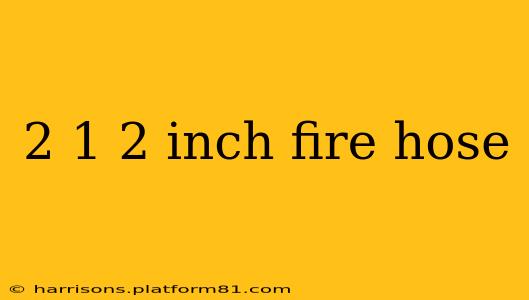Understanding 2 1/2 Inch Fire Hoses: A Comprehensive Guide
Fire hoses are critical components in firefighting operations, and understanding their specifications is crucial for effective fire suppression. This guide delves into the specifics of a 2 1/2 inch fire hose, exploring its capabilities, applications, and key considerations.
What is a 2 1/2 inch fire hose?
A 2 1/2 inch fire hose refers to a hose with a nominal inside diameter of 2 1/2 inches (63.5mm). This diameter dictates the volume of water the hose can carry, directly impacting its effectiveness in extinguishing fires. The size isn't just arbitrary; it represents a balance between water flow capacity and maneuverability. Larger diameter hoses carry more water but are harder to handle, while smaller hoses are more manageable but have lower flow rates. The 2 1/2 inch size strikes a common balance for many firefighting applications.
What are the applications of a 2 1/2 inch fire hose?
2 1/2 inch fire hoses are versatile and find use in a broad range of firefighting scenarios. They are commonly used by:
- Municipal fire departments: These hoses are a mainstay in urban and suburban fire departments, often used for structural firefighting, wildland firefighting (in conjunction with other equipment), and various rescue operations.
- Industrial fire brigades: Many industrial settings require fire protection systems, and 2 1/2 inch hoses are frequently integrated into these systems, providing a rapid response capability.
- Rural fire departments: While larger diameter hoses may be preferred in some rural contexts, 2 1/2 inch hoses remain a practical choice due to their balance of water flow and maneuverability in varied terrains.
What materials are typically used to manufacture 2 1/2 inch fire hoses?
The construction of a 2 1/2 inch fire hose is designed for durability and resistance to harsh conditions. Common materials include:
- Inner liner: Often made from a synthetic rubber or thermoplastic material to ensure smooth water flow and prevent clogging.
- Reinforcement layers: Typically composed of tightly woven textile fibers, such as polyester or nylon, providing strength and resistance to pressure.
- Outer jacket: A protective outer layer of synthetic rubber or other durable material, resistant to abrasion, weather, and chemical exposure.
The specific materials and construction techniques will vary depending on the manufacturer and the intended application (e.g., high-pressure applications may require additional reinforcement).
How much water does a 2 1/2 inch fire hose carry?
The water flow capacity of a 2 1/2 inch fire hose isn't a fixed value. It's significantly influenced by factors like:
- Water pressure: Higher water pressure leads to a higher flow rate.
- Hose length: Longer hoses experience greater friction loss, reducing flow rate.
- Nozzle type and size: The nozzle controls the water stream and greatly influences the flow and pressure at the discharge point.
To determine the actual flow rate, you'd need to consult the specifications provided by the hose manufacturer or conduct a flow test under specific conditions.
What are the different types of 2 1/2 inch fire hoses?
Fire hoses are categorized based on several factors, including their construction and intended use. While a detailed breakdown is beyond the scope of this article, it's important to know that variations exist, designed for specific needs: for example, some are engineered for high-pressure applications, others for extreme temperatures, and others for use with specific types of fire-suppressing agents.
What are the maintenance requirements for a 2 1/2 inch fire hose?
Proper maintenance is essential to ensure the longevity and effectiveness of a 2 1/2 inch fire hose. This typically involves regular inspections for damage (abrasions, cuts, kinks), cleaning to remove dirt and debris, and proper storage to prevent exposure to sunlight and extreme temperatures. Periodic pressure testing is also crucial to verify the hose's integrity. Following the manufacturer's recommendations for maintenance is paramount.
This detailed look at 2 1/2 inch fire hoses helps clarify their role in fire suppression. Remember that safety and proper training are critical when working with fire hoses. Always consult with fire safety professionals for specific guidance and training.
